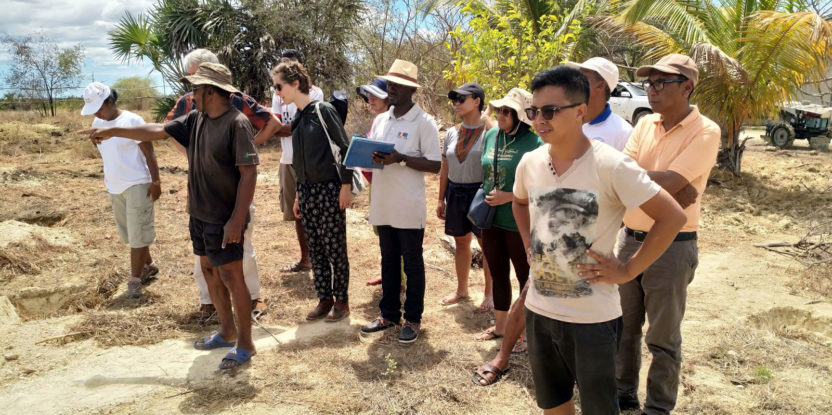by Malin Elsen, Sven Schuppener, Désiré Tchigankong and Joary Niaina Andriamiharimanana
Two weeks after Malagasy Forest Landscape Restoration experts came to Yaoundé, their Cameroonian counterparts visited Madagascar to intensify their South-South exchange on Forest and Landscape Restoration (FLR) in Africa.
The African Union Development Agency (AUDA) pilots targeted exchanges between member countries of the African Forest Landscape Restoration Initiative (AFR100) to foster peer-learning on FLR.
“Cameroon is currently drafting its national FLR strategy and our role as AFR100 secretariat is to support this process,” AUDA’s Mamadou Diakhité explains.
Madagascar is an ideal peer for Cameroon: The island country has pioneered the FLR movement by finalizing its national strategy in 2017 and advancing multi-sectoral and multilevel governance on the ground. To attain its commitment to restore 4 million hectares of degraded land, Madagascar established an inter-sectoral dialogue between relevant ministries and partners and elaborated framework documents for the implementation of FLR.
Watersheds and Mangroves
The northwestern watersheds and mangroves of Boeny were the first sites the Cameroonian delegation inspected.
Climbing down rocky hills reforested by farmers upstream and wading in the slick mud between young mangrove saplings, Mamy Arthur Randriamanana, mangrove forest restorer and local fisher, points out crab populations busily moving around.
“The crab populations so vital to sustain local fisheries returned half a year after we restored these mangroves,” he says.
Jean Jacques Jaozandry from the Ministry of Environment appreciates the questions by the Cameroonians: “The exchange helps us to move ahead with working on monitoring these ecosystem services for local fishers.”
Integrated FLR management
For Valérie Ramahavalisoa, head of the watershed and soil conservation department, the visit in Boeny confirms that a landscape approach is crucial to scale up existing restoration approaches sustainably. “It is true that punctual interventions can lead to results, but if we intensify our rice cultivation in the valleys without protecting the water source and the hills upstream, the cultivation will silt up because of soil erosion,” she explains and adds that “this is the advantage of thinking in a landscape approach.”
“In Cameroon, we will have to involve all the sectors and not only the environment and forestry. Land tenure and use, agriculture, livestock – all these issues require an integrated approach,” explains Christophe Bring, National FLR focal point in Cameroon.
“This is what became clear to us in Madagascar.” Therefore, he announced, Cameroon will move from “Forest Landscape Restoration” to “Forest and Landscape Restoration.”
Progress on the national Cameroonian FLR Strategy
The exchanges in Boeny and Tana helped the Cameroonian delegation to identify key questions about their strategy: is all necessary data available? How could the different agro-ecological zones in Cameroon be included in a FLR land management approach?
Bring finds that “the great challenge for the Cameroon is to include different tools related to environmental, forest, land-use planning and poverty reduction into our strategy.”
The debates culminated in late-night calls and last-minute changes to the Cameroonian strategy. The Malagasy experts accompanied these discussions sharing their experience with developing a common vision and integrating FLR into each ministry’s budgets.
Experts from both countries agreed that the available data would suffice to finalize Cameroon’s national strategy; however, governance and land-use management require more attention.
The group identified the design of secure land tenure options and the promotion of better land use planning as two bedrocks of successful FLR on the ground: Favorable tenure conditions and spatial planning “catalyze large scale FLR actions and should be promoted by national and regional FLR committees,” says Mrs. Rajenarison, head of the Development Department at the Malagasy Ministry of Land Use Planning.
Towards a pan-African FLR exchange
“I am satisfied with this first exchange, but I am sure that we can make it even more productive,” says Julien Noel Rakotoarisoa, national FLR focal point of Madagascar. The Cameroonian-Malagasy team recommends identifying common problems across AFR100 countries in preparation for the next exchange to intensify the technical discussions.
“How can reforestation initiatives by individuals be reinforced communally, secured in the long-term and be economically feasible even for the youth – all these questions still need an answer,” adds Jules Leonel Tadong Saa from the Cameroonian ministry of economic planning and regional development.
For Mikhail Nelson Mvongo Mkene from the Cameroonian Ministry of Forests and Wildlife, such South-South exchange between AFR100 countries is a real opportunity to jointly design FLR projects. The similarities between the issues and problems of each country, such as the sustainable management of pastures and fires in Madagascar and Cameroon should lead to formulating a joint project by FLR promoters of the two countries.
More broadly, a South-South exchange platform serves as an accelerator for technical ideas and political engagement. Such thematic exchange and other forms of peer-learning should be managed and promoted by the FLR secretariat at AUDA. It could include the creation of a pool of FLR experts on national, regional and local level.
“Specialists from one country could be paired with interested colleagues from another countries. Thereby, a bush fire management professional, for instance, can share their very specific technical knowledge,” GIZ’s Malin Elsen concludes. She and her colleagues believe that these experts could develop hands-on solutions and accompany policy makers in other countries to advance a specific process.
We want you to share Forests News content, which is licensed under Creative Commons Attribution-NonCommercial-ShareAlike 4.0 International (CC BY-NC-SA 4.0). This means you are free to redistribute our material for non-commercial purposes. All we ask is that you give Forests News appropriate credit and link to the original Forests News content, indicate if changes were made, and distribute your contributions under the same Creative Commons license. You must notify Forests News if you repost, reprint or reuse our materials by contacting forestsnews@cifor-icraf.org.
